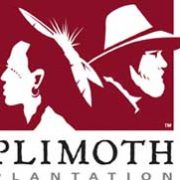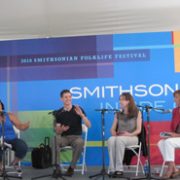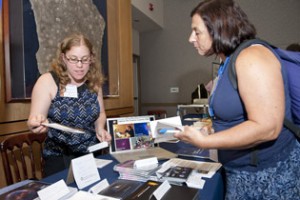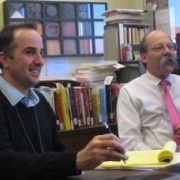We’ve invited our recent Affiliate interns and visiting professionals to blog about their experiences in our Summer at the Smithsonian series beginning in August. Shawn Pirelli, Smithsonian Affiliations intern partner from Plimoth Plantation (Plymouth, MA) will kick us off, so check back soon! Here’s a taste of what each thought of their time at the Smithsonian:
Affiliate Visiting Professionals

Eric Stanley (left) spent two weeks at the National Museum of American History researching the process of developing and designing history exhibitions.
“It was my great pleasure to be introduced to many, many facets of creating exhibitions at NMAH. I met over thirty people and was able to learn something from each of them. The time I spent with them, each one knowledgeable, enthusiastic, and warmly receptive of my presence, was a tremendous benefit to me and my institution,” said Eric Stanley, Sonoma County Museum (Santa Rosa, CA).

Chena Popper spent three weeks at the National Museum of Natural History with registrars and collections care experts.
“It was a great learning experience to be able to see the loan process from start to finish, from loan forms to insurance and shipping, arrangements to condition reporting. Then on the SDNHM side, I was able to assist with the receiving, condition reporting and installation of the pieces,” said Chena Popper, San Diego Natural History Museum (San Diego, CA).

Lisa Falk (left) benefited from a 4-week, pan-institutional project focused on technology and Web 2.0 initiatives at the Smithsonian.
“My SI colleagues were inviting, open, and encouraging. Their work is inspiring and has given me many ideas and broadened my understanding of the possibilities and some of the difficulties in creating digital and face-to-face museum interactions. Back home, I look forward to sharing what I learned with my ASM colleagues and trying out some of the Smithsonian approaches,” said Lisa Falk, Arizona State Museum (Tucson, AZ).
Affiliations Intern Partners

Annette Shumway at the National Postal Museum working to digitize the Postmaster General Collection.
“Taking part in both of these projects has helped me understand the logistics behind coordinating loans and standards involved in collections’ imaging projects. I feel that much of the experience that I gained through this period will aid in the second portion of my internship which will involve initiating a collections digitization program,” said Annette Shumway, Smithsonian Affiliations Intern Partner at the Frost Art Museum at Florida International University (Miami, FL).

Shawn Pirelli is wrapping up 10 weeks at the Smithsonian researching Thanksgiving traditions for a future exhibition.
“I have had the opportunity to work with some of the most revered curators and archivists in the world. The Smithsonian is truly an untapped gold mine in historical records. With the help of the staff, I was able to uncover some of the most truly magnificent historical records that, during their time, helped shape and change the United States,” said Shawn Pirelli, Smithsonian Affiliations Intern Partner at Plimoth Plantation (Plymouth, MA).
David Kerr alternates his internship between the National Portrait Gallery and Smithsonian Affiliations
“My Smithsonian Affiliations internship has been incredibly advantageous. From handling and transcribing Teddy Roosevelt letters to helping do research for an upcoming work on the Civil War to meeting with curators to discuss current exhibits and collections, my time has been very well spent, and my future as an academic or as a future employee can only benefit,” said David Kerr, Smithsonian Affiliations Intern Partner at the Frazier International History Museum (Louisville, KY).
Smithsonian Institution Intern

Juliana Walker (right) tests an interactive game at the National Zoo with Affiliate researcher, Lisa Falk.
“Under the direction of Harold Closter I was able to learn about the enormous positive impact the Smithsonian Affiliations Office has across the country. By researching museums in the states where Affiliates are not present, I hope my research may help extend the Affiliate network across even more,” said Juliana Walker, Junior at the State University of New York at Fredonia.
Don’t forget to visit our blog in August for stories from each of our interns and visiting professionals! Read first-hand how professional development opportunities at Smithsonian Affiliations can benefit your museum. And keep checking back for application deadlines for 2011.


















